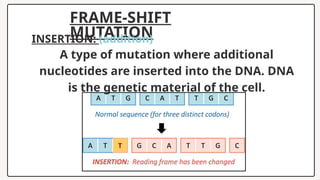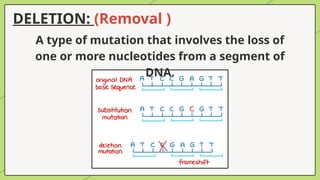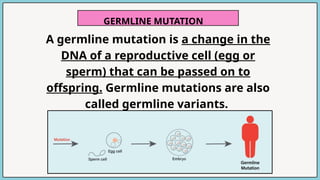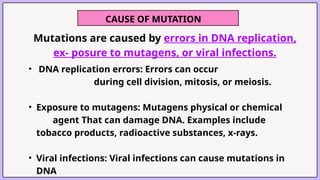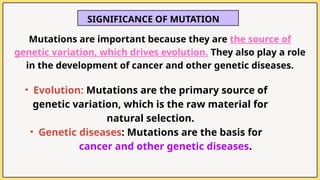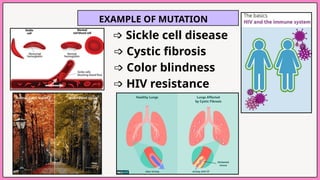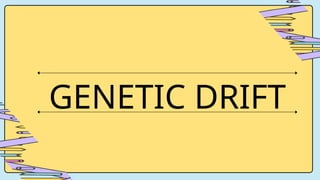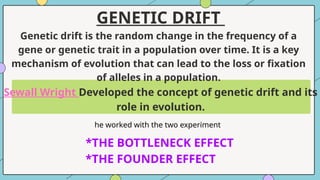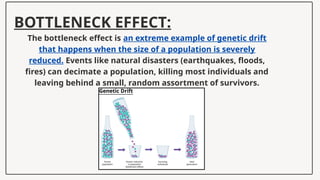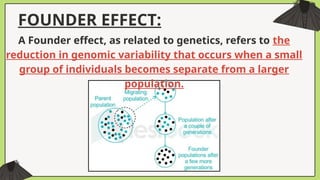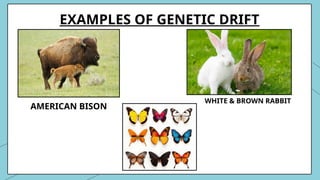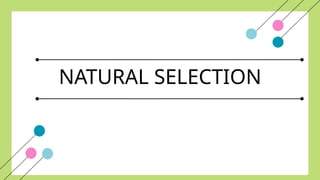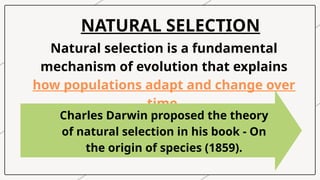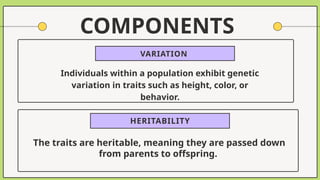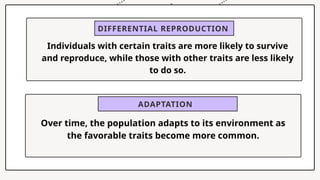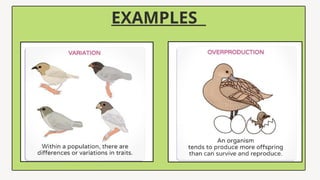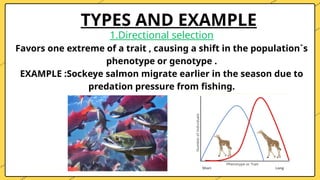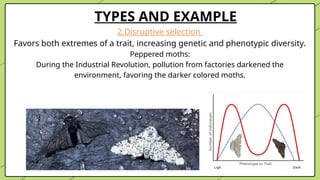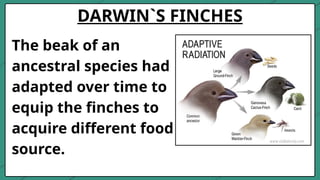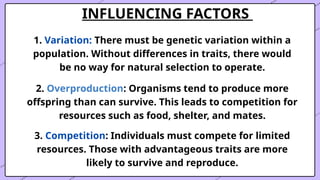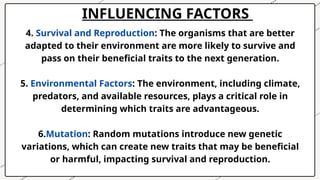MUTATION AND GENETIC DRIFT &NATURAL SELECTION
- 1. MOWLISHWARI R B .SC (Blended ) CHEMISTRY. SECOND YEAR . BHARATHIAR UNIVERSITY . SUBMISSION DATE : 27/01/2025. GENETICS,EVOLUTION AND ECOLOGY SUBMITTED BY: MUTATION AND GENETIC DRIFT & NATURAL SELECTION
- 3. . Chromosom e DNA gene INTRODUCTION Mutations are changes in the DNA sequence of an organism. They can occur spontaneously or be induced by environmental factors. COINED BY: Hugo De VRIES (1901) BOOK : THE MUTATION THEORY (1903) WORKED ON: Oenothera Lamarkiona ( evening Peimrose )
- 4. TYPES OF MUTATION CHROMOSOMAL MUTATION GENE MUTATION Deletion Inversion Duplication Translocatio n POINT MUTATION FRAME - SHIFT MUTATION Substitutio n Insertion Deletion GERMLINE MUTATION SOMATIC MUTATION
- 5. CHROMOSOMAL MUTATION Chromosomal mutations are changes in the structure or number of chromosomes, which can affect the genetic information encoded in the DNA.
- 6. 1.DELETION: A deletion, as related to genomics, is a type of mutation that involves the loss of one or more nucleotides from a segment of DNA.
- 7. 2. INVERSION : A chromosomal inversion is a genetic mutation that occurs when a segment of a chromosome breaks off and reattaches in the opposite direction. This changes the genetic code and can cause abnormalities in offspring.
- 8. 3.DUPLICATIO N : Chromosomal duplication is a type of mutation that occurs when a section of a chromosome is duplicated, creating an extra copy of the DNA. This can happen in any organism, but it's especially common in plants.
- 9. 4.TRANSLOCATION : chromosomal translocation is a genetic mutation that occurs when a piece of a chromosome breaks off and attaches to another chromosome. This can cause flaws in the chromosomes.
- 11. POINT MUTATION SUBSTITUTION : A substitution in a point mutation is when a single base in a DNA sequence is replaced with another base. This type of mutation is also known as a base substitution
- 12. TRANSITION & TRANSVERSION NITROGENOUS BASES OF PURIN & PYRIMIDIN TRANSITION: i] A=G ii] C=G TRANSVERSIONS : i] ATC ii] CTC
- 13. FRAME-SHIFT MUTATION INSERTION: (addition) A type of mutation where additional nucleotides are inserted into the DNA. DNA is the genetic material of the cell.
- 14. DELETION: (Removal ) A type of mutation that involves the loss of one or more nucleotides from a segment of DNA.
- 15. A germline mutation is a change in the DNA of a reproductive cell (egg or sperm) that can be passed on to offspring. Germline mutations are also called germline variants. GERMLINE MUTATION
- 16. A somatic mutation is a change in the DNA sequence of a somatic cell, which is any cell in the body that isn't a germ cell (sperm or egg). Somatic mutations are not hereditary and can't be passed on to children. SOMATIC MUTATION
- 17. CAUSE OF MUTATION Mutations are caused by errors in DNA replication, ex- posure to mutagens, or viral infections. ŌĆó DNA replication errors: Errors can occur during cell division, mitosis, or meiosis. ŌĆó Exposure to mutagens: Mutagens physical or chemical agent That can damage DNA. Examples include tobacco products, radioactive substances, x-rays. ŌĆó Viral infections: Viral infections can cause mutations in DNA
- 18. SIGNIFICANCE OF MUTATION Mutations are important because they are the source of genetic variation, which drives evolution. They also play a role in the development of cancer and other genetic diseases. ŌĆó Evolution: Mutations are the primary source of genetic variation, which is the raw material for natural selection. ŌĆó Genetic diseases: Mutations are the basis for cancer and other genetic diseases.
- 19. EXAMPLE OF MUTATION Ō×® Sickle cell disease Ō×® Cystic fibrosis Ō×® Color blindness Ō×® HIV resistance
- 20. GENETIC DRIFT
- 21. GENETIC DRIFT Genetic drift is the random change in the frequency of a gene or genetic trait in a population over time. It is a key mechanism of evolution that can lead to the loss or fixation of alleles in a population. Sewall Wright Developed the concept of genetic drift and its role in evolution. he worked with the two experiment *THE BOTTLENECK EFFECT *THE FOUNDER EFFECT
- 22. BOTTLENECK EFFECT: The bottleneck effect is an extreme example of genetic drift that happens when the size of a population is severely reduced. Events like natural disasters (earthquakes, floods, fires) can decimate a population, killing most individuals and leaving behind a small, random assortment of survivors.
- 23. FOUNDER EFFECT: A Founder effect, as related to genetics, refers to the reduction in genomic variability that occurs when a small group of individuals becomes separate from a larger population.
- 24. EXAMPLES OF GENETIC DRIFT AMERICAN BISON WHITE & BROWN RABBIT
- 25. IMPACT OF GENETIC DRIFT Genetic drift is a random process that changes the frequency of gene variants in a population. It can have a number of effects, including ŌĆó Reduced genetic variation: Genetic drift can cause the loss of rare alleles and gene variants, which reduces the genetic variation in a population. ŌĆó Evolution of new species: Genetic drift may play a role in the evolution of new species.
- 27. Natural selection is a fundamental mechanism of evolution that explains how populations adapt and change over time. NATURAL SELECTION Charles Darwin proposed the theory of natural selection in his book - On the origin of species (1859).
- 28. The traits are heritable, meaning they are passed down from parents to offspring. HERITABILITY VARIATION COMPONENTS Individuals within a population exhibit genetic variation in traits such as height, color, or behavior.
- 29. DIFFERENTIAL REPRODUCTION Individuals with certain traits are more likely to survive and reproduce, while those with other traits are less likely to do so. ADAPTATION Over time, the population adapts to its environment as the favorable traits become more common.
- 30. EXAMPLES
- 32. TYPES AND EXAMPLE 1.Directional selection Favors one extreme of a trait , causing a shift in the population`s phenotype or genotype . EXAMPLE :Sockeye salmon migrate earlier in the season due to predation pressure from fishing.
- 33. TYPES AND EXAMPLE 2.Disruptive selection Favors both extremes of a trait, increasing genetic and phenotypic diversity. Peppered moths: During the Industrial Revolution, pollution from factories darkened the environment, favoring the darker colored moths.
- 34. 3.Stabilizing selection: Favors the average phenotype, selecting against extreme variation EXAMPLE : a population of mice living in the woods, natural selection may favor mice that blend in best with the forest floor. OP
- 35. DARWIN`S FINCHES The beak of an ancestral species had adapted over time to equip the finches to acquire different food source.
- 36. INFLUENCING FACTORS 1. Variation: There must be genetic variation within a population. Without differences in traits, there would be no way for natural selection to operate. 2. Overproduction: Organisms tend to produce more offspring than can survive. This leads to competition for resources such as food, shelter, and mates. 3. Competition: Individuals must compete for limited resources. Those with advantageous traits are more likely to survive and reproduce.
- 37. INFLUENCING FACTORS 4. Survival and Reproduction: The organisms that are better adapted to their environment are more likely to survive and pass on their beneficial traits to the next generation. 5. Environmental Factors: The environment, including climate, predators, and available resources, plays a critical role in determining which traits are advantageous. 6.Mutation: Random mutations introduce new genetic variations, which can create new traits that may be beneficial or harmful, impacting survival and reproduction.
- 38. THANK YOU !
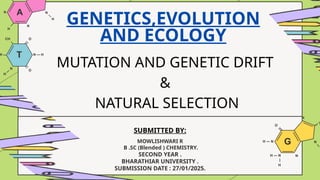
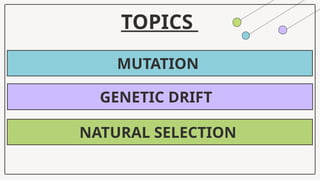
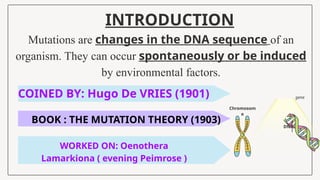
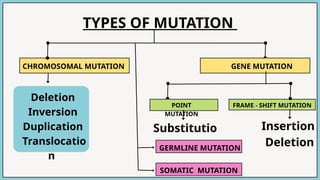
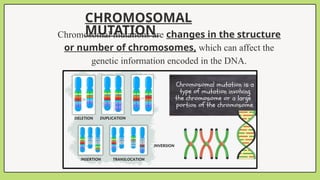
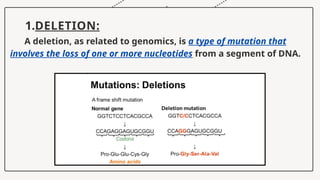
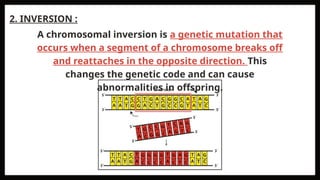
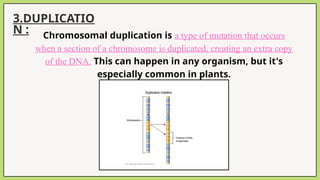
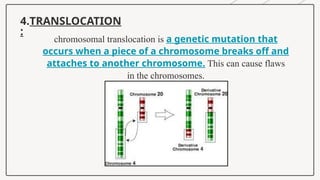
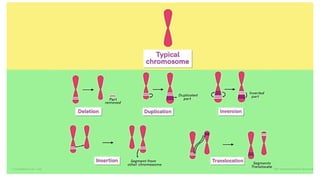
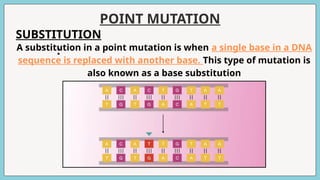
![TRANSITION &
TRANSVERSION
NITROGENOUS BASES OF PURIN & PYRIMIDIN
TRANSITION:
i] A=G
ii] C=G
TRANSVERSIONS :
i] ATC
ii] CTC](https://image.slidesharecdn.com/mowlishwarirbiologyppt2-250403072537-ed7a1120/85/MUTATION-AND-GENETIC-DRIFT-NATURAL-SELECTION-12-320.jpg)
